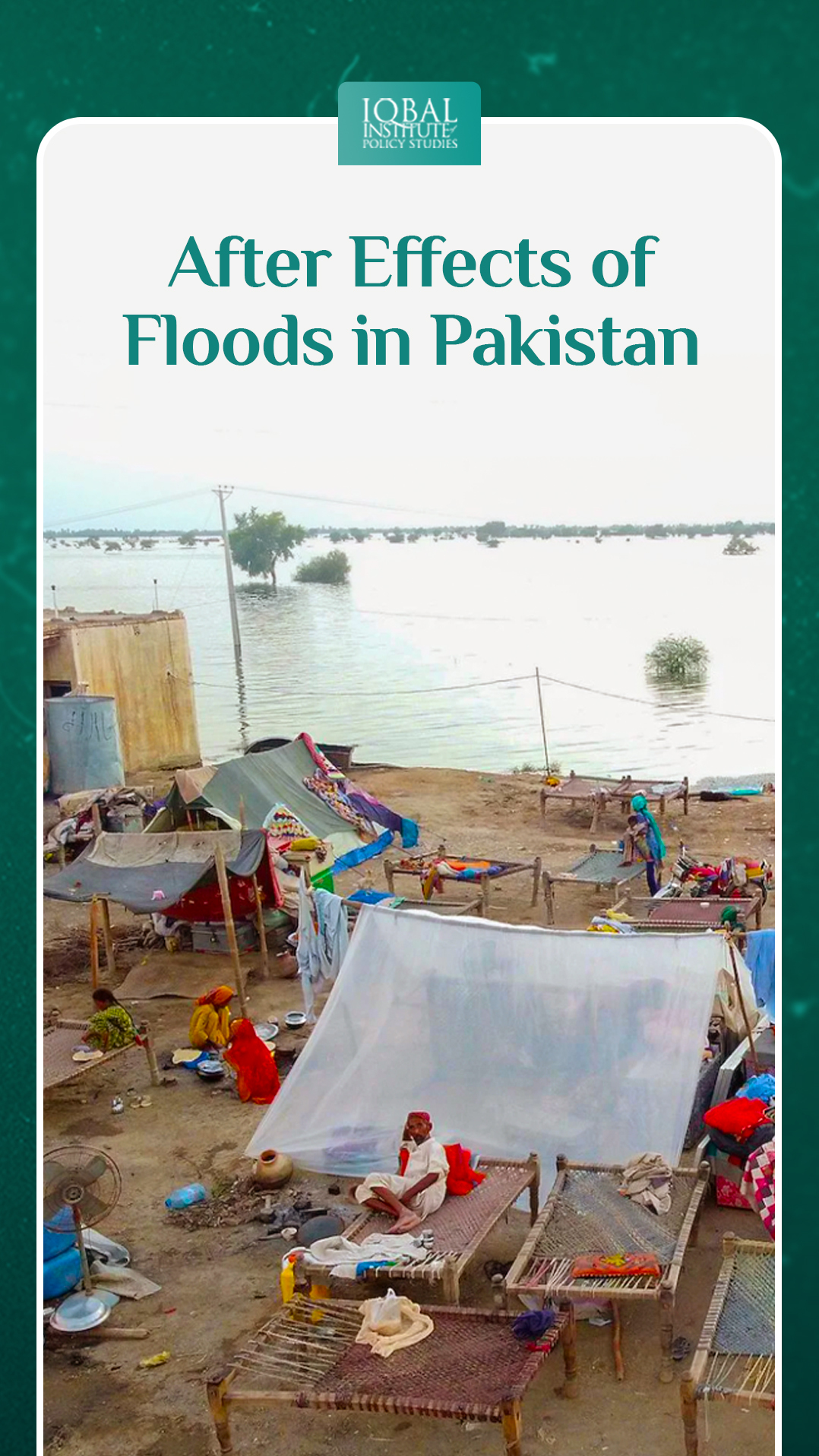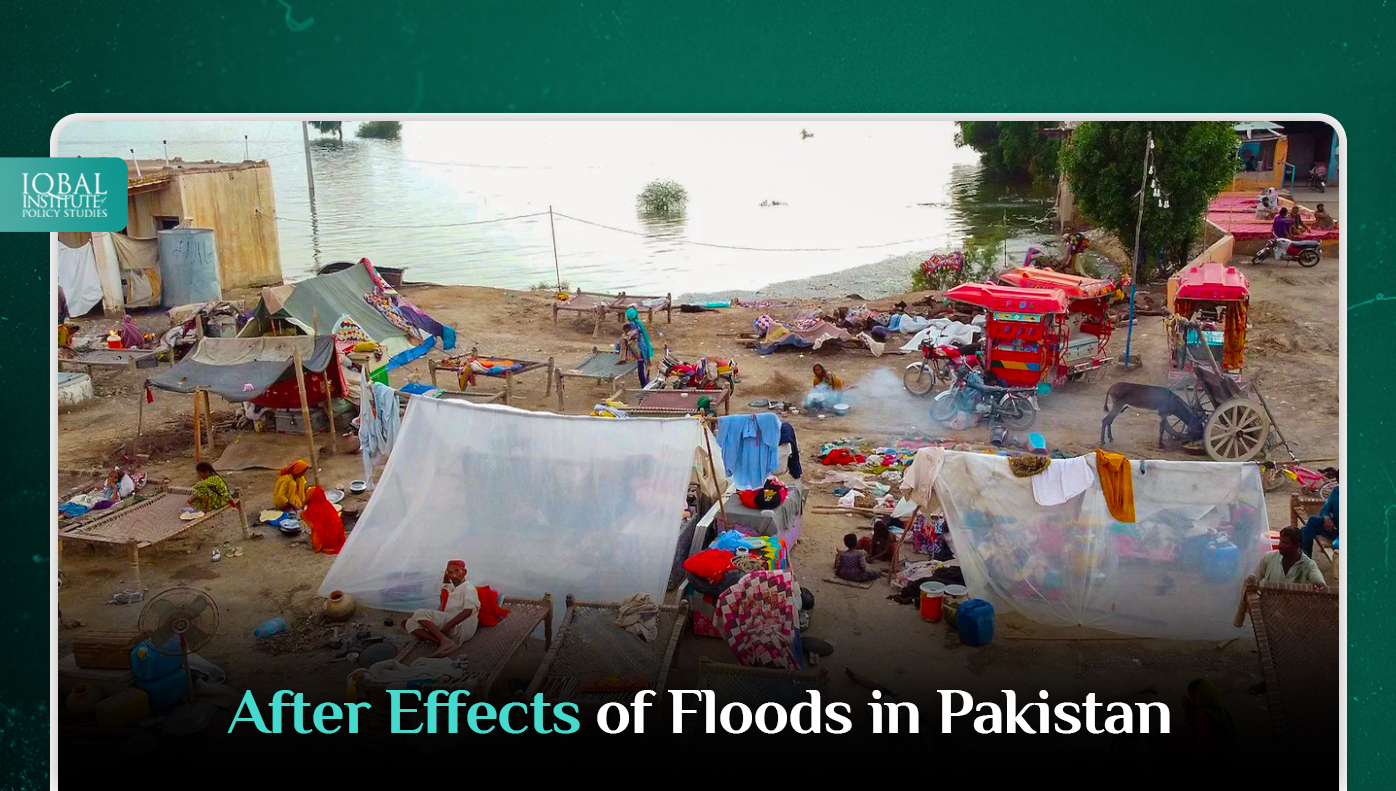Flooding is the most prevalent disaster risk factor, considerably raising mortality and morbidity rates worldwide. In addition to being a humanitarian catastrophe, the recent flooding in Pakistan poses serious security risks and a health crisis. The situation is not solely caused by climate change. Environmental degradation, bad ecological governance, and foreign policy are also to fault. The floods were compounded worse by deforestation, unauthorised development near waterways, and inadequate drainage systems. The nation’s flood response plans lacked the technical know-how and specificity to handle such a calamity. The strain of the current crisis, on top of the already constrained capacity of the government and the diversion of a political dispute between the political parties, runs the risk of tipping the nation into further instability. Millions of displaced individuals have returned to their homes amid the flood waters’ ongoing retreat. However, many people still need humanitarian aid within these populations due to the substantial flood damage to water sources, other infrastructure, agricultural lands, and livelihoods. Integrating climate hazards and existing vulnerabilities endangers national, regional, and global security.
Indirect Impacts of Floods
Health Crisis
Disease outbreaks, poor access to clean water, sanitation, medicine, adequate food, and other necessities are all problems that Pakistanis must deal with. Cholera, malaria, dengue, scabies, lumpy skin disease, hand, foot and mouth disease, as well as zoonotic diseases affecting cattle, are all on the rise. Children are particularly susceptible to acute respiratory infections, diarrhoea, malaria, malnutrition, skin conditions, and typhoid in camps for displaced people. The UN noted a peak of roughly 100,000 cases of malaria in the nation in the middle of October or about two months after the flooding (OCHA, 2022).
Water Scarcity
Flooding contaminates drinking water, reduces water supply, obliterates water management infrastructure, and introduces diseases that can only be spread through water. This year, the conflict will continue and possibly worsen in several areas of Pakistan, according to the WPS Early Warning Tool (Burke, Saccoccia, Schmeier, Faizee, & Chertock, 2023).
Food insecurity
According to the International Atomic Energy Agency, agriculture is highly susceptible to natural disasters such as floods, which cause significant harvest and livestock losses. Crops on at least 4 million acres have been damaged (Baloch, 2022). Farmers failed to plant new crops as the planting season began, and many agricultural lands remained flooded. Experts predict a secondary hunger crisis if crop yields fall short next year (Reuters, 2022). Already, anaemic mothers are giving birth to babies with extremely low birth weights (United Nations, 2022). The consequences for food security are not limited to Pakistan. Pakistan is a major exporter of wheat and rice, both of which are presumed to be affected by the floods (Naz, 2022). This also jeopardises Pakistan’s commitment to sell these crops to the World Food Programme to alleviate food insecurity in Afghanistan. This occurs amid high inflation and food prices, partly due to the Russian invasion of Ukraine and supply chain disruptions caused by the COVID pandemic, raising the risk of food insecurity. According to the UN, an additional 1.1 million Pakistanis will face emergency food security conditions in early 2023 (OCHA, 2022).
Energy Shortage
In Pakistan, just 25% of people have access to power, and there is an increasing need to produce more energy (Burke, Saccoccia, Schmeier, Faizee, & Chertock, 2023). Pakistan intends to double its hydropower output over the next seven years to compensate for its electricity shortfall (Business Standard, 2023). However, reliance on hydropower increases the likelihood of transboundary water issues or heightened tensions between state actors over water issues.
Mass Displacement
The summer floods wiped away entire villages, leaving tens of millions without lifesaving assistance (UNICEF, 2022)and forcing over 3.4 million children to flee their homes (United Nations, 2022). Pakistan is undergoing mass displacement due to the destruction of millions of homes; the need for massive refugee camps and internal movement may increase competition in hosting communities.
Damaged Infrastructure
Critical infrastructure, including bridges, residences, hospitals, public health facilities, highways, and schools, have been devastated due to the flooding and accompanying landslides. Also, public health and national security are at risk due to the collapse of rural infrastructure and irrigation systems.
Jeopardise National Security
While increasing political unrest, Pakistan was struck by the flooding disaster and humanitarian crisis. Pakistan urgently requires international and adaptation assistance to develop climate resilience and prepare for future disasters. A failure to provide government assistance during natural disasters such as this one may undermine the legitimacy of the current administration, which is already on shaky ground. Protests have already taken place, accusing the government of inadequate flood relief. Such unrest might lead to a power vacuum, leaving Pakistan, a nuclear-armed nation, open to outside forces, extremist groups, and others.
The Way Forward
Governments should implement integrated water resource management that considers the demands for water resources from all competing groups and incorporates improved data to guide resource distribution.
Instead of using techniques like flooding fields, farmers can convert to more water-efficient crops or better target irrigation water.
The government must Invest in environmentally friendly solutions: Wetlands and forests, for example, enhance water quality and disperse supply over longer periods, increasing resilience to droughts and floods.
Wastewater can be treated and used again, turning it from a waste product into a freshwater supply with wastewater treatment techniques.
Investing in and maintaining flood protection infrastructure can aid in preventing mortalities and creating local jobs.
Initiatives for adaptation and resilience include developing and enhancing early warning systems and rebuilding outside of flood plains.
Introduce a strong political reform through negotiation, mediation, mediation-arbitration, diplomacy, and creative peacebuilding.
Conclusion
Flooding has significantly affected Pakistanis’ food, health, and other aspects of human security. The situation is not solely caused by climate change. Weak policies, inadequate ecological governance, and environmental deterioration are also responsible. The government, citizens, and non-governmental organisations must collaborate to rebuild what has been lost in the floods, build resilience, and prepare beforehand for future calamities. International organisations must also play their part by cutting their carbon emissions to lessen the pace of climate change and its aggravating impacts on climate-vulnerable countries like Pakistan.
References
Baloch, S. M. (2022, October 12). ‘We have no dry land left’: impact of Pakistan floods to be felt for years. Retrieved from The Guardian: https://www.theguardian.com/world/2022/oct/12/pakistan-floods-impact-years-crops-farms
Burke, S., Saccoccia, L., Schmeier, S., Faizee, M., & Chertock, M. (2023, February 14). How Floods in Pakistan Threaten Global Security. Retrieved from World Resources Institute: https://www.wri.org/insights/pakistan-floods-threaten-global-security
Business Standard. (2023, April 3). Pakistan to double hydroelectric output to meet power shortage: Report. Retrieved from https://www.business-standard.com/article/international/pakistan-to-double-hydroelectric-output-to-meet-power-shortage-report-122043000713_1.html
Naz, F. (2022, October 28). Floods are tipping Pakistan into a food crisis. Retrieved from Aljazeera: https://www.aljazeera.com/opinions/2022/10/28/floods-are-tipping-pakistan-into-a-food-crisis
OCHA. (2022, December 6). Pakistan: 2022 Monsoon Floods – Situation Report No. 12 (As of 5 December 2022). Retrieved from relief web: https://reliefweb.int/report/pakistan/pakistan-2022-monsoon-floods-situation-report-no-12-5-december-2022
Reuters. (2022, November 2). First heat, then floods wipe out farms in Pakistan’s chilli capital. Retrieved from https://www.reuters.com/investigates/special-report/climate-un-pakistan-chili/
Unicef. (2022, October 7). UNICEF warns that more children in Pakistan will die without immediate international support and revises funding to US$173.5 million. Retrieved from https://www.unicef.org/press-releases/unicef-warns-more-children-pakistan-will-die-without-immediate-international-support
United Nations. (2022, September 21). Media Update: United Nations Pakistan, 20 September 2022. Retrieved from https://pakistan.un.org/en/200228-media-update-united-nations-pakistan-20-september-2022
United Nations. (2022, September 20). Media Update: United Nations Pakistan, 20 September 2022. Retrieved from United Nations Pakistan: https://pakistan.un.org/en/200228-media-update-united-nations-pakistan-20-september-2022



Leave a Reply